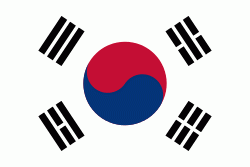Gwangju Airport (Kwangju Ab)
Gwangju Airport (Hangul: 광주공항, Hanja: 光州空港, Revised Romanization of Korean: Gwangju Gonghang, McCune-Reischauer: Kwangju Konghang) is an airport in the city of Gwangju, South Korea and is managed by the Korea Airports Corporation. In 2018, 1,986,125 passengers used the airport. This airport is planned to close when Muan International Airport becomes more established. Because Gwangju Airport is sharing with military, taking photograph or video of apron, runway and military facility is strictly prohibited.
The airport was established in November 1948. It saw its first commercial flight in 1950. At the time, however, it was not located in Gwangju but in neighboring Jangseong, on a military training facility. The airport moved to its present location in Sinchon-dong, Gwangsan-gu, in 1964. It was taken over by the Korea Airports Corporation in 1990. The current airport terminal was built in 1994, at which time the old terminal was repurposed as a Cargo terminal.
The airport was established in November 1948. It saw its first commercial flight in 1950. At the time, however, it was not located in Gwangju but in neighboring Jangseong, on a military training facility. The airport moved to its present location in Sinchon-dong, Gwangsan-gu, in 1964. It was taken over by the Korea Airports Corporation in 1990. The current airport terminal was built in 1994, at which time the old terminal was repurposed as a Cargo terminal.
| IATA Code | KWJ | ICAO Code | RKJJ | FAA Code | |
|---|---|---|---|---|---|
| Telephone | Fax | ||||
| Home page |
Map - Gwangju Airport (Kwangju Ab)
Map
Country - South_Korea
 |
 |
| Flag of South Korea | |
The Korean Peninsula was inhabited as early as the Lower Paleolithic period. Its first kingdom was noted in Chinese records in the early 7th century BCE. Following the unification of the Three Kingdoms of Korea into Silla and Balhae in the late 7th century, Korea was ruled by the Goryeo dynasty (918–1392) and the Joseon dynasty (1392–1897). The succeeding Korean Empire (1897–1910) was annexed in 1910 into the Empire of Japan. Japanese rule ended following Japan's surrender in World War II, after which Korea was divided into two zones; a northern zone occupied by the Soviet Union and a southern zone occupied by the United States. After negotiations on reunification failed, the southern zone became the Republic of Korea in August 1948 while the northern zone became the communist Democratic People's Republic of Korea the following month.
Currency / Language
| ISO | Currency | Symbol | Significant figures |
|---|---|---|---|
| KRW | South Korean won | â‚© | 0 |
| ISO | Language |
|---|---|
| EN | English language |
| KO | Korean language |















